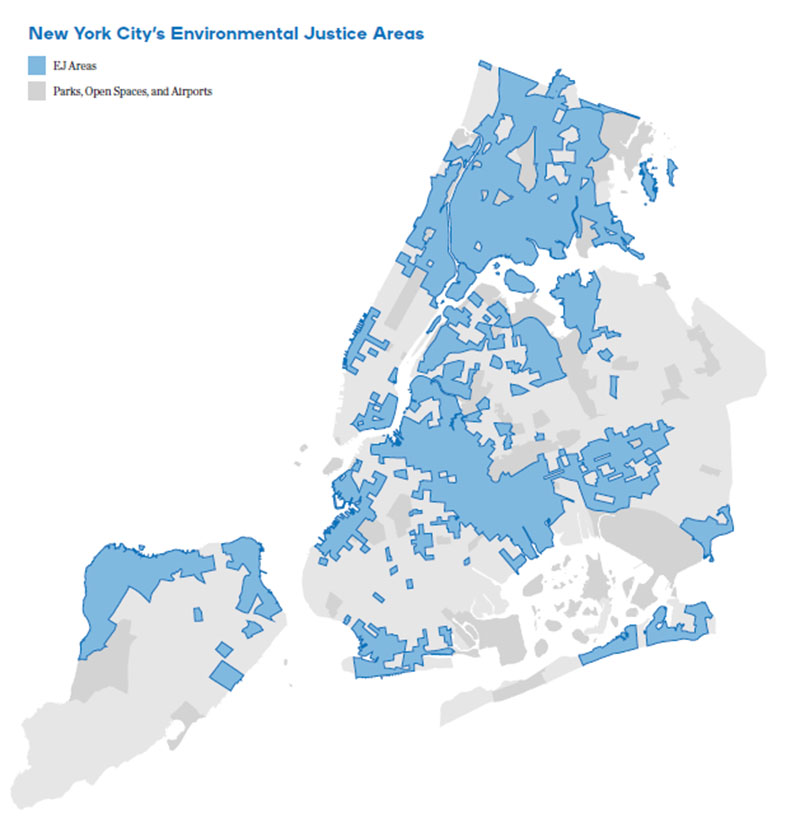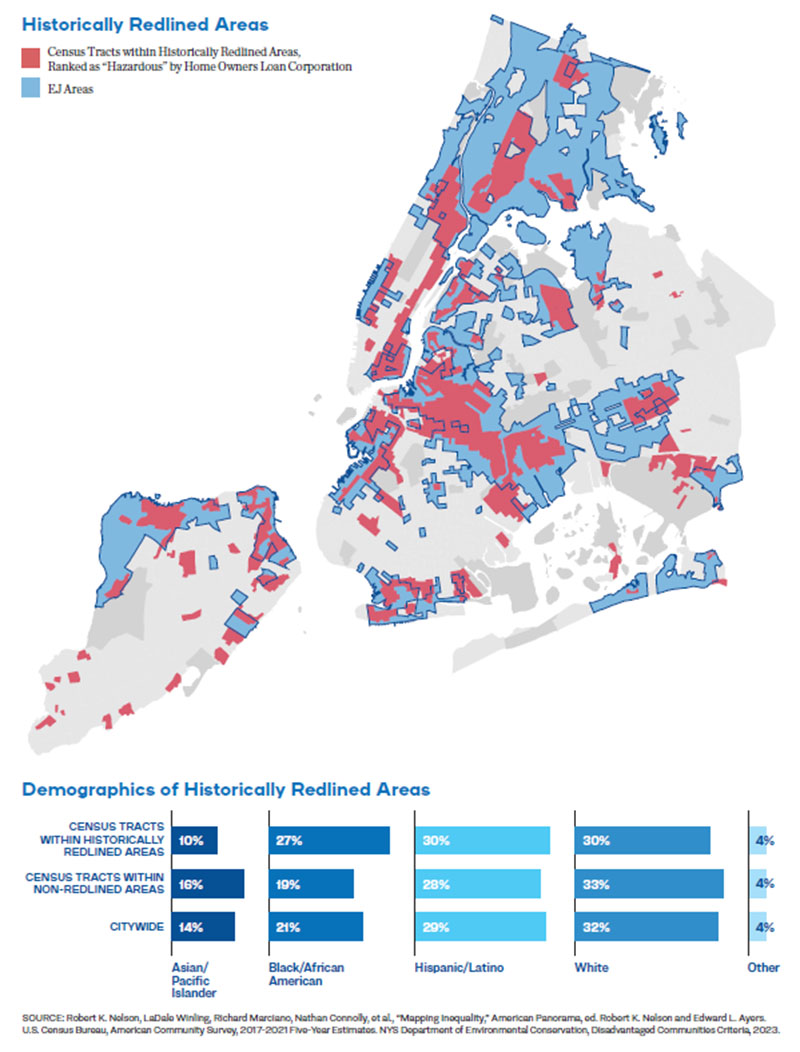Buro Happold team studies climate, environmental justice

Manhattan, NY Buro Happold has debuted a comprehensive report on environmental inequities released by the New York City Mayor’s Office of Climate and Environmental Justice, or MOCEJ. The report, EJNYC: A Study of Environmental Justice Issues in New York City, hailed as the first of its kind in U.S. history, explores a range of environmental hazards from toxin exposure and summer heat vulnerability to flood risks and transit access. The report reinforces what environmental justice (EJ) advocates and researchers have been saying for decades: that the city’s low-income residents and communities of color are most vulnerable to environmental inequities.
Developed by a team led by Buro Happold and the community-centered urban design nonprofit Hester Street, this comprehensive, 200-plus-page study of environmental inequities lays the foundation for the next step of the Environmental Justice NYC (EJNYC) initiative, which is the development of a comprehensive citywide environmental justice strategy called the EJNYC Plan. According to David Bigio, a senior consultant in Buro Happold’s acclaimed Cities practice who led the EJNYC consultant team, the EJNYC report’s findings provide city leaders with the basis for identifying opportunities to advance environmental justice across New York’s five boroughs. These opportunities, to be explored further in the forthcoming EJNYC Plan, include:
 • Investing in target areas called environmental justice communities.
• Investing in target areas called environmental justice communities.
• Integrating environmental justice in agency decisions through a systematic approach known as climate budgeting.
• Improving accountability through increased data transparency and communication.
• Coordinating with permitting and regulatory authorities to embed equity and environmental justice considerations in the siting and permitting of infrastructure.
• Exploring and developing new ways to collaborate with environmental justice communities.
“In the pursuit of environmental justice, studying the problems and creating consensus around the facts are critical first steps to developing equitable policies,” said Bigio, who also worked on the city’s recently released Green Economy Action Plan.
“The information and opportunities identified in the EJNYC report will support policymakers, advocates, and community members to collaboratively develop an environmental justice plan that helps close the gap on environmental and health disparities in our city.”
The EJNYC report is also accompanied by a web-based interactive mapping tool that allows New Yorkers to identify environmental hazards in their neighborhoods. According to Sarah Smyth, a senior consultant in Buro Happold’s Cities practice, the mapping tool is designed to support ongoing advocacy and environmental justice action led by ordinary citizens as well as policymakers and community leaders.
“Data transparency is foundational to advancing environmental justice,” said Smyth. “Democratizing access to accurate and comprehensive information empowers communities to advocate for change as it also holds decision-makers accountable and ensures that no one is left behind in major collective efforts to advance environmental justice.”
Supporting Buro Happold, Hester Street, and New York City’s MOCEJ on this environmental justice initiative is a diverse and multidisciplinary team, including Rhie Planning, HOUSEOFCAKES, WXY Studio, Creative Urban Alchemy, Ki Strategies, Lion Advisors, UHope Consulting, and New Deal Strategies. To deliver the EJNYC report and mapping tool, the consultant team worked closely with the Environmental Justice Interagency Working Group — comprising staff members from 19 City of New York agencies — and the Environmental Justice Advisory Board, which is made up of nationally recognized environmental justice advocates and local subject matter experts.

The team was engaged by the Mayor’s Office in mid-2022 as a result of Local Laws 60 and 64, environmental justice legislation passed by the City Council and signed into law in 2017 requiring the citywide study of environmental justice, with its findings to be made public.
The EJNYC report studies key Environmental Justice Areas, known as EJ Areas — drawn from New York State’s Disadvantaged Communities or DAC criteria — created from 45 indicators that represent the environmental burdens or climate change risks within a community, or population characteristics and health vulnerabilities that can contribute to more severe adverse effects of climate change. DACs or EJ Areas comprise 44% of all New York City census tracts and 49% of its population. Residents of these areas are predominantly Hispanic or Latino (43%, compared to 29% citywide) and Black (27%, compared to 21% citywide).
The new EJNYC report finds that EJ Areas have:
• More stationary sources of pollution, including “peaker power plants,” waste processing facilities, and hazardous waste generators.
• More observed health disparities, such as more pollution-attributable emergency department visits.
• Greater exposure to emissions from heavy-duty diesel vehicles due to the location of arterial highways, commercial waste routes, delivery routes, and parking facilities for medium and heavy-duty fleets.
• Greater exposure to flooding due to coastal storm surge, chronic tidal flooding, and extreme rainfall in the current decade.
“Prevalent and persistent environmental inequities in New York City create profound economic, social, and health disparities among affected communities,” according to the EJNYC study. “Achieving environmental justice will require that all New Yorkers have the same degree of protection from environmental and health hazards and equal access to the decision-making to have a healthy environment to live, learn, and work.”
“The EJNYC Report and EJNYC Mapping Tool are critical to ensuring that environmental justice is a driving force in any new environmental policies,” said Alice Shay, a principal in Buro Happold’s Cities practice. “It is also a critical step in assessing the cumulative impacts of environmental hazards on our more vulnerable and underserved communities.”
AmTrustRE completes $211m acquisition of 260 Madison Ave.


Strategic pause - by Shallini Mehra and Chirag Doshi

Lasting effects of eminent domain on commercial development - by Sebastian Jablonski

Behind the post: Why reels, stories, and shorts work for CRE (and how to use them) - by Kimberly Zar Bloorian









.jpg)
.gif)
.gif)